Recent Articles
Popular Makes
Body Types
2020 Volkswagen Atlas Cross Sport Road Test and Review
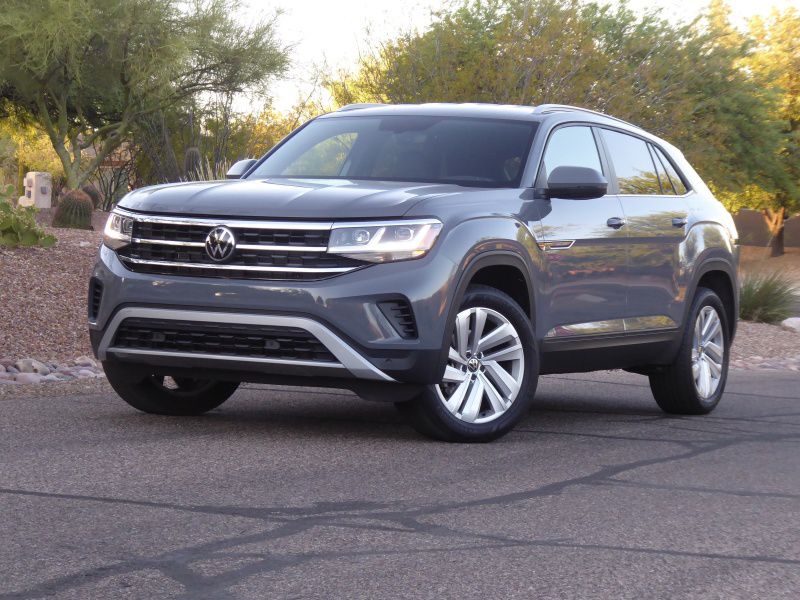
2020 Volkswagen Atlas Cross Sport ・ Photo by Ron Sessions
Channeling the big, roomy, five-passenger Touareg, Volkswagen has created a new, generously proportioned two-row SUV from the bones of its biggest three-row utility, the Atlas. Unlike the recently discontinued expensive, imported-from Europe Touareg, the new-for-2020 Volkswagen Atlas Cross Sport is a stylish new entry that goes head-to-head on price with mainstream five-seaters such as the Chevrolet Blazer, Ford Edge, Jeep Grand Cherokee, Nissan Murano, and Honda Passport, among others.
The 2020 Atlas Cross Sport is available in eight trim levels, starting at $31,565 (including the $1,020 destination charge) for the front-wheel-drive Atlas Cross Sport S and topping out at $50,765 including destination for the range-topping 4Motion-equipped SEL Premium R-Line trim.
An SUV With Attitude
Custom car builders have been chopping and lowering the roofs of cars for years, creating something that’s sleeker and more stylish. For the Cross Sport, designers took the tall and roomy Atlas seven-passenger SUV, kept the same long wheelbase, big wheel openings, and high-riding stance. Then they pared just enough visual mass off the roof and cargo area to create a sportier variant that offers the same sort of curb appeal and road presence as the twice-as-expensive Audi Q8.
Aside from 5.5 inches sliced from the Atlas’s overall length, and a 2.2-inch lowered and steeply raked roof, the Cross Sport gets more aggressive-looking front and rear fascias, an expressive three-bar grille and all-LED exterior lighting, front and rear, and wheel sizes up to 20 or 21 inches. It’s quite a makeover.
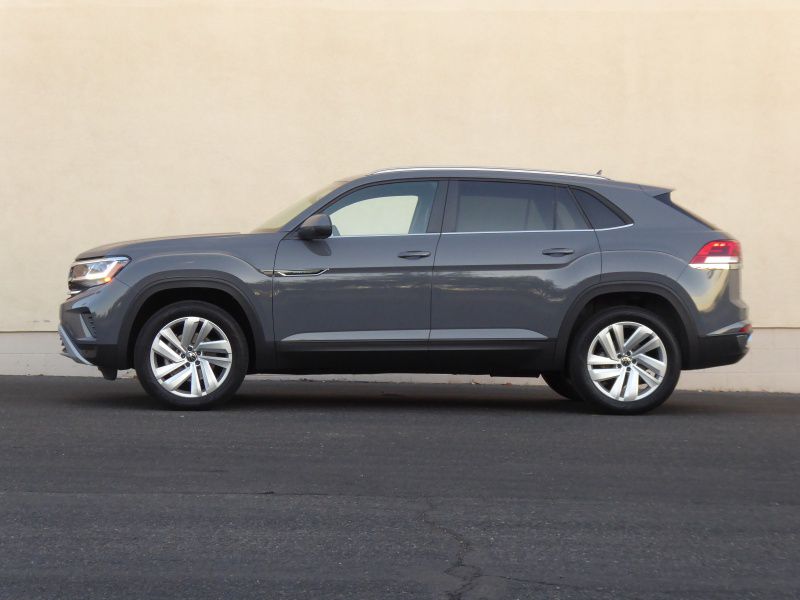
Photo by Ron Sessions
Powertrain Possibilities
There are two Atlas Cross Sport engine choices, both pairable with front-wheel drive or Volkswagen’s 4Motion all-wheel drive. The surprisingly lively and responsive 2.0-liter four-cylinder turbo available in the S, SE, and SEL models develops 235 horsepower and 258 lb-ft of torque, while the silky, naturally aspirated 3.6-liter V6 available in the SE with Technology, SE R-Line, SEL, and SEL Premium trims offers 276 hp and 266 lb-ft. Both are teamed with a crisp-shifting eight-speed automatic.
EPA estimates for the front-drive four-cylinder are 21 mpg city/24 mpg highway/22 mpg combined. Adding all-wheel drive drops 4-cylinder fuel economy estimates to 18 mpg city/23 mpg highway/20 mpg combined. The front-drive V6 is EPA-rated at 17 mpg city/23 mpg highway/19 mpg combined and 16 mpg city/22 mpg highway/19 mpg combined with AWD. During a week spent with a front-drive Cross Sport SE with the four-cylinder turbo in mixed residential and highway driving, I saw an indicated average 23 mpg. The V6 is the one you want if you plan to tow. Max towing with the V6 engine equipped with a factory-installed hitch is 5,000 lbs. The tow rating shrinks to 2,000 lbs with the four-cylinder turbo, but it’s the one for driving enthusiasts.
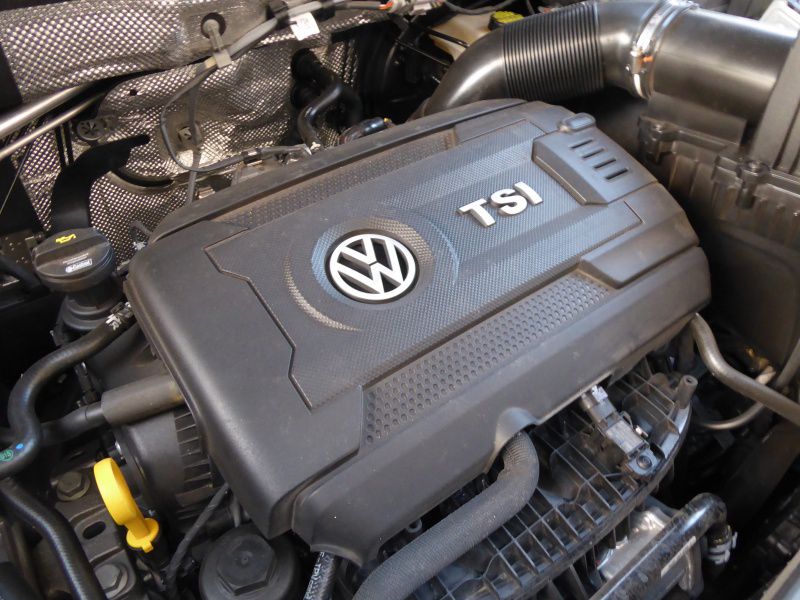
Photo by Ron Sessions
Room to Roam
While the Cross Sport’s exterior is stylish and expressive, its cabin is plain and functional. There’s plenty of hard plastic trim inside, and switchgear has an economy-grade look and feel. What the Atlas Cross Sport delivers is lots of spread-out room and an extensive list of standard features at an attractive price. Storage is generous courtesy of a large, covered console bin beneath the center armrest and an open bin forward of the shifter.
All but the base S trim gets a dual-zone automatic climate control system along with push-button start, keyless access to all four doors, and a leather-wrapped steering wheel. SEL and higher trims add a heated steering wheel as well as a driver-customizable digital cockpit featuring a 10-inch TFT display for vehicle information between the large speedometer and tachometer. The Cross Sport’s firm but accommodating front bucket seats deliver all-day driving support. Seat coverings are a plaid-like cloth for the base S model, upgrading to faux-leather for the SE and real leather for the SEL Premium. The SE adds heated front seats, a power-adjustable driver’s seat, and the SEL brings driver’s seat memory and a power-adjustable front passenger seat. The SEL Premium adds ventilated front seats.
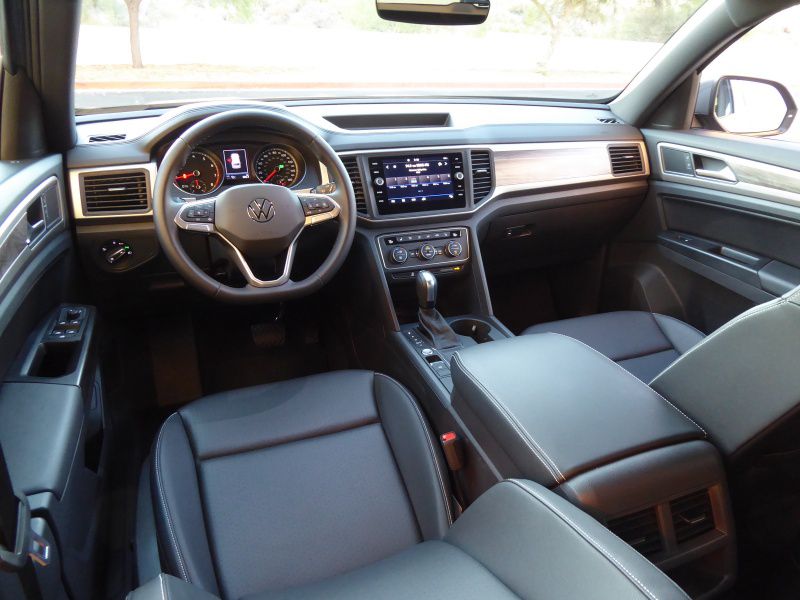
Photo by Ron Sessions
Touchscreen Infotainment
The base Atlas Cross Sport S is equipped with a 6.5-inch color infotainment touchscreen, while all other trims get the larger 8-inch touchscreen pictured here. Both run smartphone apps such as Apple CarPlay and Android Auto plus send and receive SMS text messages via Bluetooth. The touchscreen is easy to use while driving courtesy of large on-screen tiles and shortcut buttons, along with analog volume and tuning knobs at the edges, plus voice-activated commands. There are four USB type-A ports for charging and connectivity. A wireless cellphone charger is included in SE and higher trims.
Cross Sport S and SE trims come with a six-speaker AM/FM stereo with SiriusXM and HD Radio while SEL and higher trims upgrade to a 12-speaker, 480-watt Fender premium audio system, filling the spacious cabin with high-quality sound. SEL Premium models add navigation. All Cross Sport trims include Car-Net connected services accessed via a mobile phone or smartwatch at no charge for the first five years. Available services include remote access for things like vehicle locking and unlocking, vehicle maintenance reminders, finding parking locations, young-driver curfew, and other geofencing features. $20 per month provides Verizon in-vehicle 4G LTE Wi-Fi for up to four devices.

Photo by Ron Sessions
Back Seat
The roomy back seat has nearly as much headroom and legroom as the front buckets. The 60/40 split rear bench reclines up to 14 degrees and folds flat for maximum cargo room.
SE trims and higher include a folding center armrest with dual cup holders, and the SEL Premium adds seat heaters for the outboard passengers. Manual pull-down rear-door sunshades in SEL Premium trim add privacy and reduce the need for sunscreen lotion in the aft compartment.
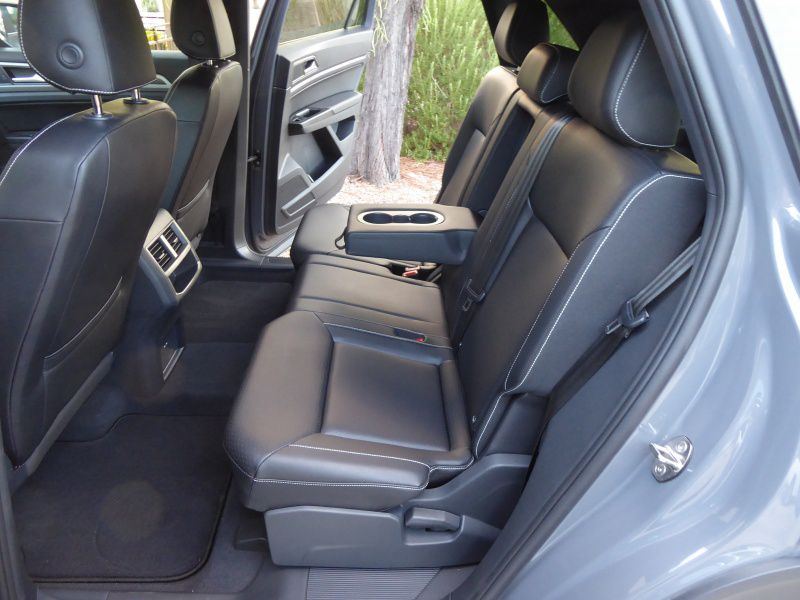
Photo by Ron Sessions
Max Cargo
With no third-row seat getting in the way, cargo space behind the rear seat is a voluminous 40.3 cubic feet. That figure increases to 77.8 cubic feet with the rear seat folded flat — not the cavernous 96.8 cubic feet available in the longer, taller-roofed seven-passenger Atlas, but capacious nonetheless.
Access to the cargo hold is via a power liftgate on SE and higher trims. With the remote in your pocket, a foot kick under the rear bumper opens the power liftgate hands-free on the Cross Sport SE with Technology trim and above. Underfloor is additional, hidden-from-view storage in the spare tire well for small items such as laptops, tablets, purses, cameras, and such.
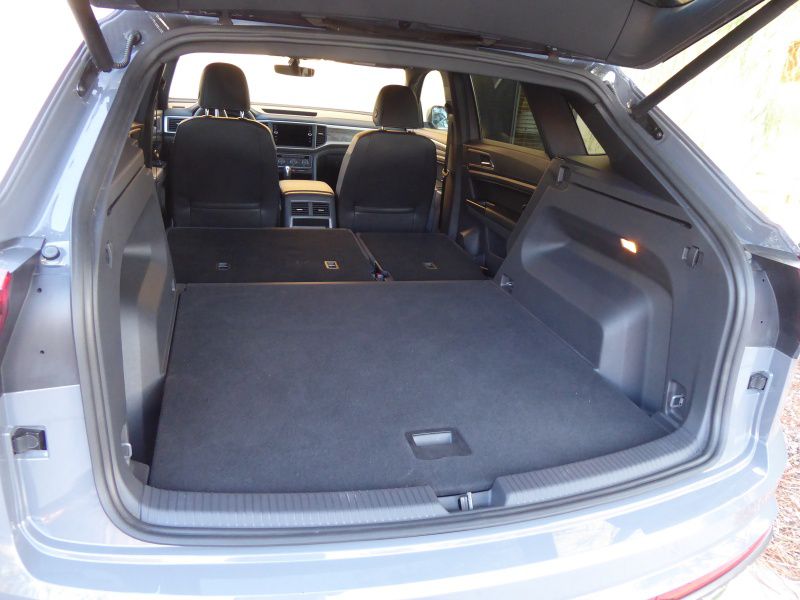
Photo by Ron Sessions
Safety and Driver-Assistive Systems
Standard safety gear on all trims includes six airbags, a forward collision warning with pedestrian protection and automatic emergency braking, automatic post-collision braking, a backup camera (with dynamic trajectory lines on SE and higher trims), blind-spot monitoring (with steering assist on SEL and higher trims), and rear cross-traffic monitoring with automatic braking.
Adaptive cruise control with stop and go and front and rear park distance control are added on SE w/Tech trims. SEL brings lane-keeping assist, traffic jam assist (which works to accelerate, steer, and brake the vehicle automatically up to 37 mph when adaptive cruise control is engaged), automatic high beams, and road sign recognition. SEL Premium adds parallel and perpendicular parking steering assist and an overhead view to the backup camera. Remote start is an option on the S and SE trims and standard on SE with Technology and higher trims. In Insurance Institute for Highway Safety testing, the 2020 Volkswagen Atlas Cross Sport received Good scores for small- and medium-offset front impacts, side impacts, roof strength, seats, and head restraints but only Marginal scores for child-seat anchors as well as headlamp effectiveness on the S and SE trims.
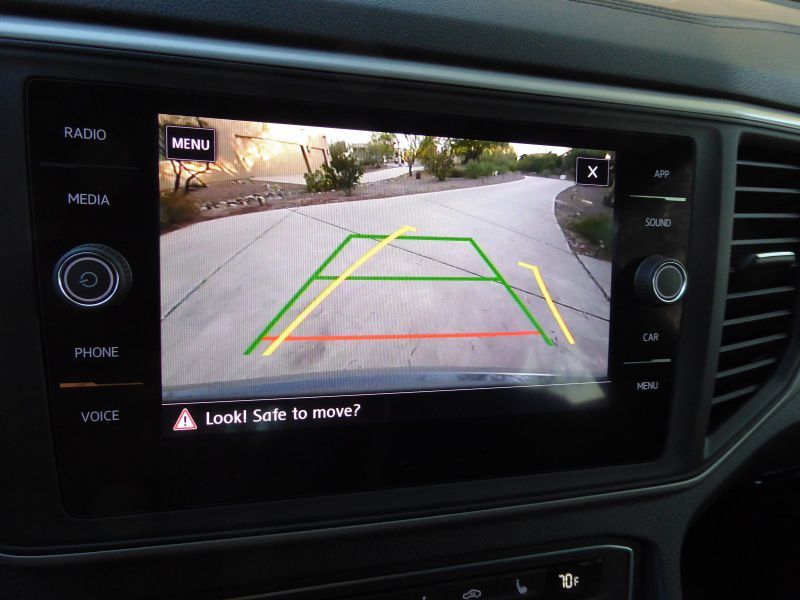
Photo by Ron Sessions
4Motion AWD With Active Control
Both four-cylinder and V6 Cross Sports can be equipped with 4Motion all-wheel drive. The part-time system operates in front-drive mode under most low-load and coasting conditions, but it can distribute up to 50 percent of drive torque to the rear wheels on demand via the center differential. Constantly monitoring driving conditions, 4Motion can activate AWD predictively, even before wheelspin occurs.
Active Control gives the driver the ability to select from Onroad, Snow, Offroad, and Custom Offroad driving modes that tailor throttle response, transmission shifts, steering, adaptive cruise control, and traction control settings. Using a rotary knob and push-button controls, the driver can further fine-tune the Onroad setting and choose among Normal, Eco, Sport, and Individual options in pop-up menus in the infotainment screen.
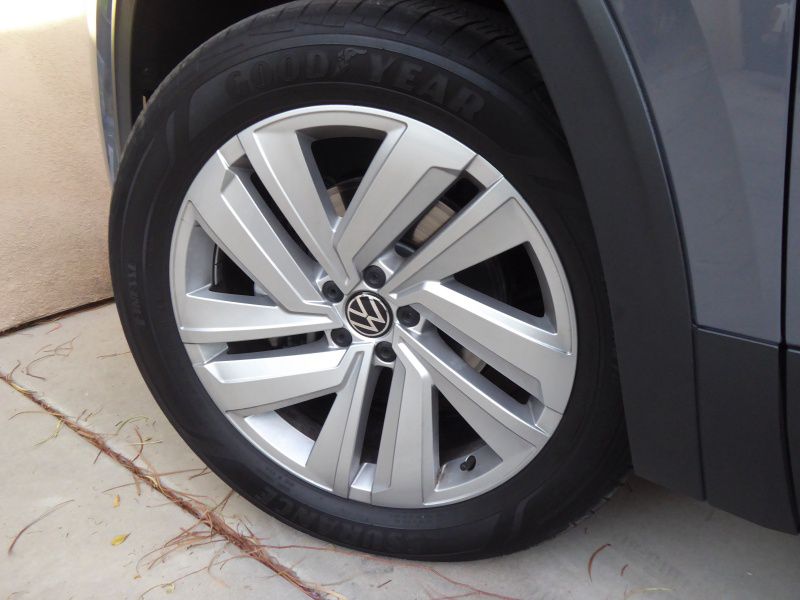
Photo by Ron Sessions
Driving Dynamics
Providing a solid building block for the Cross Sport’s chassis bits is Volkswagen’s robust MQB Modular Transverse Matrix architecture. The Cross Sport offers fairly supple ride quality while maintaining good vertical body control over all sorts of road surfaces. Body roll is minimal in corners. Four-cylinder S and SE models come standard with 18-inch aluminum wheels, SE w/Technology and higher trims with the V6 engine roll on 20-inchers, and R-Line versions are fitted with 21-inch alloys. All-season tire sizes range from ample 245/60-18s up to meaty 265/45-21s.
The electrically-boosted variable-ratio rack-and-pinion steering is pleasingly precise. On the highway, it’s easy to keep the Cross Sport on heading without constant adjustments, while the relatively light-effort steering responds enthusiastically to driver inputs on twisty sections of road. Good brakes are a given from a German brand, and the Cross Sport doesn’t disappoint. Top-of-pedal response is crisp, and stopping power from speed is reassuring. The Cross Sport drives smaller than it looks. Particularly, the Cross Sport’s four-cylinder turbo, shared with the Golf R hot hatch, motivates the two-ton-plus SUV with enthusiasm and feels lively regardless of engine speed. It develops full torque from just 1,600 rpm, assuring good throttle response even in relaxed driving.
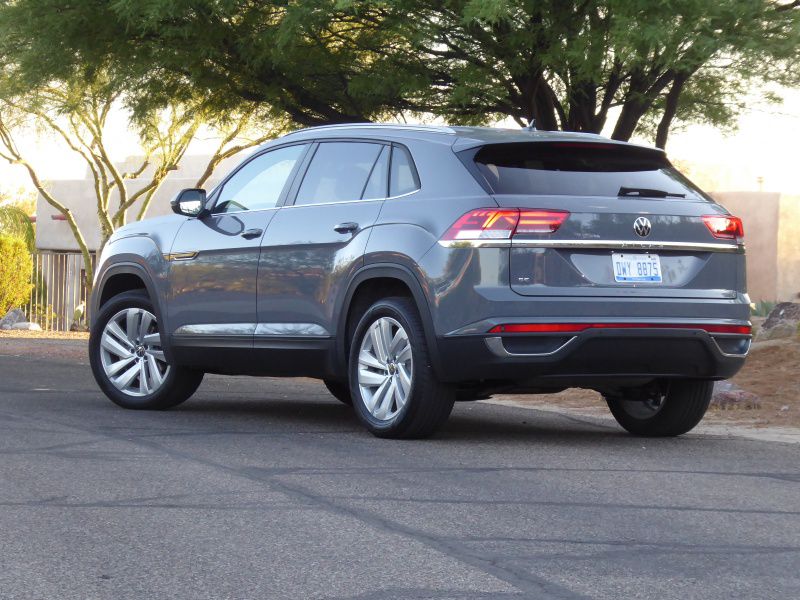
Photo by Ron Sessions
European Flavor, American Value
Assembled in Chattanooga, Tennessee, the Atlas Cross Sport combines the generous interior proportions Americans tend to prefer with the refined driving dynamics expected of a product from a European brand with sporty coupe-like styling. And the Cross Sport does this at a price point usually associated with Japanese, Korean, or U.S.-branded offerings.
The Atlas Cross Sport in SE with Technology trim we tested offers a particularly good value with such standard niceties as 20-inch wheels, automatic climate control, push-button start, a power driver’s seat, faux-leather seat trim, a hands-free power liftgate, an 8.0-inch touchscreen with Apple CarPlay and Android Auto, adaptive cruise control, and park distance control. It’s a smart choice for small families looking for a stylish crossover and five roomy seats with tons of spread-out space. Although not as generous as the company’s previous six-year/72,000-mile bumper-to-bumper warranty offered just after Volkswagen’s diesel emissions scandal, the current transferable four-year/50,000-mile bumper-to-bumper warranty with two years/20,000 miles of free maintenance is a plus as well.
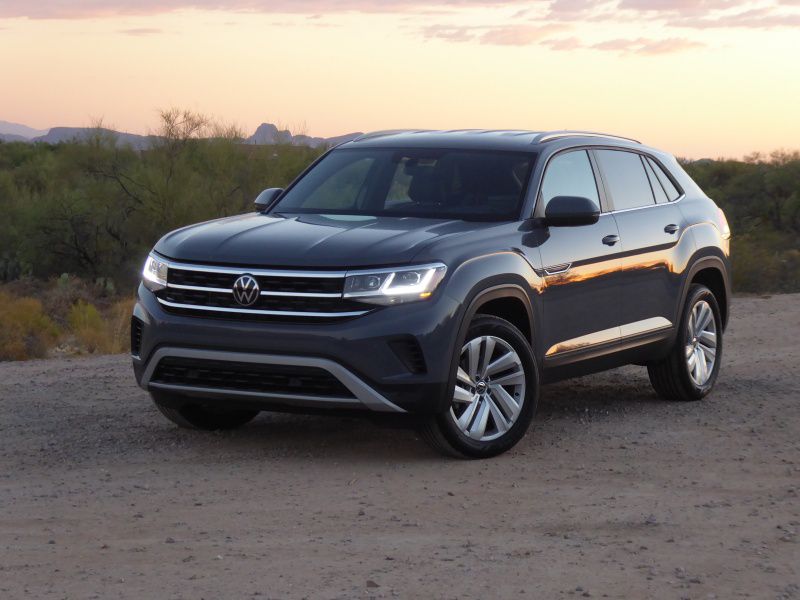
Photo by Ron Sessions